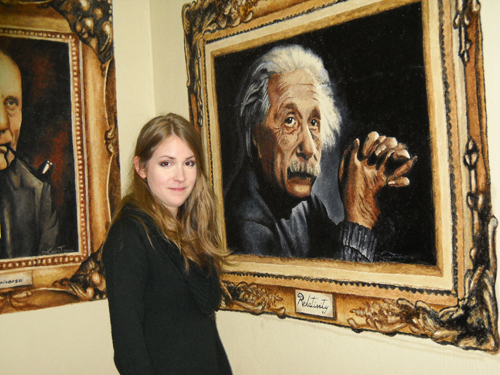
Bill Fraser is a big fan of the stars — and of the stars of astronomy. So last year, when the fifth-year philosophy student was pondering how to mark the International Year of Astronomy, he came up with an idea. Why not create a lasting “wall of fame” and highlight the U of G observatory at the same time?
The result, unveiled in March, is a new portrait gallery of astronomy’s leading lights adorning the walls of the upper stairwells in the MacNaughton Building leading to the rooftop telescope.
The portraits were rendered directly on the walls mural-style by fourth-year fine art student Laura Tomona.
Pause on the sixth-floor landing, and you encounter Nicolaus Copernicus, Galileo, Johannes Kepler and Isaac Newton. One floor up are portraits of Einstein, Edwin Hubble, Nobel laureate Subramanyam Chandrasekhar and Stephen Hawking.
Tomona painted them in a warm chiaroscuro style that echoes the dramatic lights and darks of Caravaggio, one of her favourite artists.
Commissioned last fall, she completed the series in early March. She visited almost daily between classes, standing atop milk crates and applying acrylics to copy likenesses from photos and earlier portraits.
“I didn’t know much about science,” says Tomona, who drew and painted while growing up in Caledon East. “It was kind of an adventure.”
A self-described realist, she has painted landscapes, architecture, theatre sets and contemporary portraits (http://artem-anima.deviantart.com).
Realistic portraits were what Fraser had in mind when he advertised on campus for an artist last year. Actually, he was thinking then about a single likeness of astrophysicist and science popularizer Carl Sagan.
He commissioned Tomona to do that work, which now graces the top-floor landing before the doorway to the observatory itself. “Once I started that, I said I might as well keep going,” says Fraser, who heads the U of G Astronomy Club.
After getting approval and funding from the Department of Physics, he approached student groups to pay for most of the project.
The new series spans five centuries, beginning with Copernicus, who in the early 1500s proposed that the planets circle the sun. His portrait is called “Heliocentricity.”
All of the series’ subjects are left unnamed. Instead, their portraits are labelled for their contributions, including “Telescopic Observation,” “Expanding Universe,” “Relativity” and “Black Holes.”
Fraser, who plans to pursue grad studies in the philosophy of math, says he wanted to engage visitors in a kind of name-the-astronomer game.
“The history of astronomy is a history of great ideas. I’m sure most people are going to associate gravity with Isaac Newton. Kepler or Hubble or Chandrasekhar may be less well-known.”